Our last stop while in the area was Arlington National Cemetery.
We read the information about the cemetery as we waited for the tour and learned that there may be up to 30 funerals PER DAY at the cemetery. I had no idea there were still so many burials And then as the guide started her informational talk, we learned that today there were 29 planned. 29!
The first tour stop was the site of the Kennedy memorials. As a child we visited the cemetery shortly after President Kennedy was killed. I have a really, really poor memory about most things but I was so interested in everything Kennedy back then it made an impression on me that his grave was surrounded by a white picket fence and the eternal flame.
So, of course, I googled it and immediately found this. Aha - my memory is better than I thought!
Photo by Rob Ketcherside
Included was information about the grave posted by the photographer, Rob Ketcherside. The photo was taken in 1964 (that's probably the year we were there) by his grandfather.
On the left is the headstone of President Kennedy's son, Patrick Bouvier Kennedy, who was born premature and died after two days. On the right is the cross headstone of his still-born daughter, Arabella (although their daughter was never named, Jackie later referred to her as Arabella). Their graves were moved (Patrick from Holyhood Cemetery in Brookline, Massachusetts; Arabella from Newport, Rhode Island) just a few weeks after the President was assassinated. You can see the temporary eternal flame to the right of and below the white wreath. President Kennedy was buried on November 25, 1963 and the children were reburied on December 5, 1963. All three were moved to the permanent gravesite in March, 1967.
The large markers are the president on the left, Jacqueline on the right
The two small markers are Patrick on the left, Arabella on the right
Other family members are now in the family section.
Robert Francis Kennedy, 1925-1968
Edward Moore Kennedy, 1932-2009
The eldest child of Joseph and Rose Kennedy, and the older brother of President Kennedy, Joseph P. Kennedy Jr. was killed in World War II when his plane exploded mid-air, killing him instantly. His remains were never found. There is now a memorial for him in the Kennedy section.
Joseph P. Kennedy, Jr. 1915-1944
The view from this portion of the cemetery is not only of the city, but also the Arlington House, which was once the home of Robert E. Lee and his wife, Mary Custis, a great granddaughter of George Washington. It was formerly named the Custis-Lee Mansion. During the Civil War the grounds of the mansion were selected as the site of Arlington National Cemetery, in part to ensure that Lee would never again be able to return to his home. The mansion has since been designated as a National Memorial. More on the Arlington House later.
Arlington House from the JFK Memorial
We walked over to what's called Supreme Court Hill. A few familiar names.
Ruth Bader Ginsburg, 1933-2020
Warren Earl Burger, 1907-1995
Thurgood Marshall, 1908-1993
Back to the tram for a ride to the next stop, the Tomb of the Unknown Soldier.
On November 11, 1921, President Warren G. Harding officiated at the interment ceremonies at the Memorial Amphitheater and the Unknown from World War I was placed in the Tomb.
On May 30, 1958 President Eisenhower awarded the Medal of Honor to the Unknown of World War II and the Korean War before they were interred in the plaza beside their World War I comrade.
On May 28, 1984, President Reagan presided over the funeral and presented the Medal of Honor to the Vietnam Unknown and also acted as next of kin by accepting the interment flag at the end of the ceremony.
In 1994, it was determined the remains of the Vietnam Unknown were likely those of Air Force 1st Lt. Michael Joseph Blassie, who was shot down near An Loc, Vietnam, in 1972. The body was exhumed on May 14, 1998 and based on mitochondrial DNA testing, scientists confirmed the remains were those of Blassie. The identification was announced on June 30, 1998, and on July 10, Blassie's remains arrived home to his family in St. Louis where he was reinterred at Jefferson Barracks National Cemetery.
The slab over the crypt that once held the remains of the Vietnam Unknown has since been replaced. The original inscription of "Vietnam" has been changed to "Honoring and Keeping Faith with America's Missing Servicemen 1958-1975" as a reminder of the commitment of the Armed Forces. It was decided the crypt would remain vacant.
Of course the changing of the guard ceremony is a big draw and is very respectful. It occurs every half hour during the summer and every hour during the winter, 24 hours per day, 365 days per year.
We bought a DVD at the gift shop which we have since watched and it was very interesting to learn about the tomb guards who are members of the United States Army. They describe it as an honor of their lifetime to guard the Unknowns.
The soldier (or sentinel) "walking the mat" does not wear rank insignia so as not to outrank the Unknowns, whatever their ranks may have been. Out of respect for the interred, the sentinels command silence at the tomb. If the guard walking the mat must vocally control a disturbance from spectators, or a threat, the routine is interrupted and remains so until the disturbance is under control.
The sentinels remain on the cemetery grounds for their shift (25 hours) and rest, dress, etc. in the quarters underneath the amphitheater. This is the entrance to that area.
As we were waiting for the tram to take us to our next stop, we visited some important memorials.
Crew of the Challenger, 1986
Crew of the Columbia, 2003
Members of the United States Armed Forces who died during an attempt to rescue American hostages held in Iran
23 April 1980
Audie Murphy, 1924-1971
Last stop was the Arlington House.
The memorial in the front (pictured above and below) contains over 2,000 unidentified of Civil War soldiers. After the war, presidents and families visited this space to honor the fallen.
We went inside the mansion. An example of one of the rooms.
White Parlor
And then we milled around the grounds nearby and found some other interesting graves.
Abner Doubleday 1819-1895
Col. and Bvt. General U.S. Army, Major General of Volunteers
We learned about Montgomery C. Meigs above. Our daughters will remember the nickname our daughter, Megan, was given of Montgomery C. Meigs from a friend when we visited the area years ago.
Montgomery C. Meigs, 1816-1892
Brigadier General Brevet Major General U.S. Army, Quartermaster General
We stopped for a funeral procession as they went by. It was very solemn.
Last trip on the tram was back to the Visitor Center. We had a few more graves we wanted to visit.
Omar Bradley, 1893-1981
General of the Army
Besides John F. Kennedy, the only other president interred in Arlington is William Howard Taft, the 27th president of the United States.
William Howard Taft, 1857-1930
It seems that Abraham Lincoln references are everywhere and this was no exception. The sarcophagus of his eldest son and his only child to live to adulthood, Robert Lincoln and his wife and son. His name will come up again in a future blog post.
Robert Todd Lincoln, 1843-1926
Mary Harlan Lincoln, 1846-1937
Abraham Lincoln II, 1873-1890
As we left, we took a walk past the Women in Military Service for America Memorial. This memorial honors women who have served in the United States Armed Forces. The structure in which the memorial is housed was originally known as the Hemicycle and built in 1932 to be a ceremonial entrance to the cemetery. It never served this purpose and was in disrepair by the 1980s. Congress approved the memorial in 1985, and the Hemicycle approved as the site for the memorial in 1988. An open design competition was won by New York City architects Marion Weiss and Michael Manfredi. Their original design was leaked to the public, and caused significant controversy. Two years of fund-raising and design revision followed. A revised preliminary design was approved in July, 1992, and the final design in March, 1995. Ground was broken for the memorial in June, 1995 and the structure was dedicated on October 18, 1997.
Phew, we were tired. Although a walking trail is available, we climbed in the truck for one final stop.
The United States Marine Corps War Memorial (Iwo Jima Memorial) was dedicated in 1954 to all Marines who have given their lives in the defense of the United States since 1775. The memorial was inspired by the iconic 1945 photograph of six Marines raising the U.S. flag atop Mount Suribachi during the Battle of Iwo Jima in World War II taken by Associated Press combat photographer Joe Rosenthal.
The memorial consists of front and rear inscriptions, and inscribed in gold letters around the polished black granite upper base of the memorial is the date and location of every United States Marine Corps major action up to the present time.
While Ron's father did not serve in the Marine Corps, he was at the Marshall Islands as a member of the United States Army during World War II. So I snapped a picture.
Thank you for your service, all military personnel buried in these hallowed grounds.







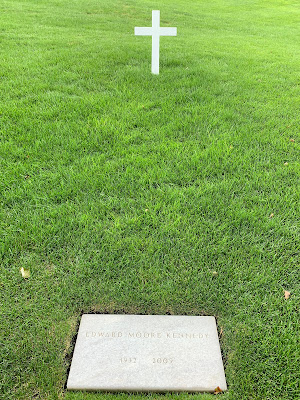


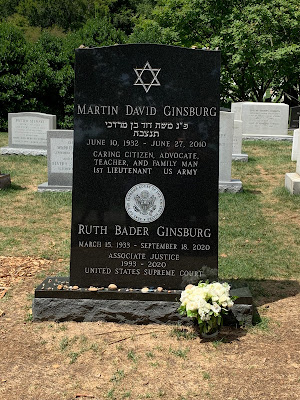






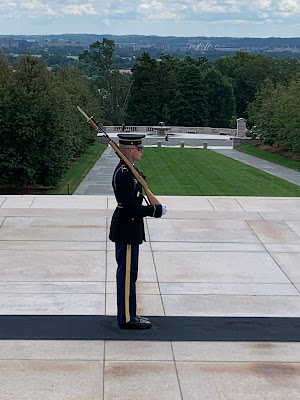

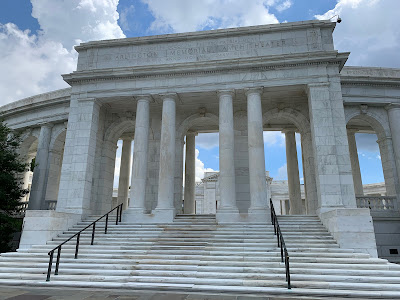











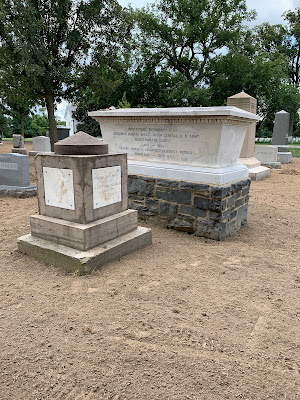






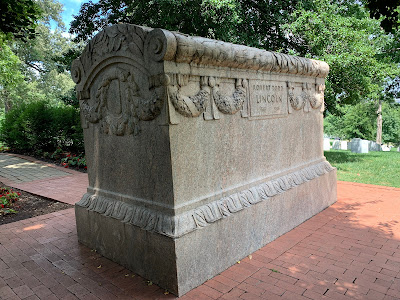







No comments:
Post a Comment